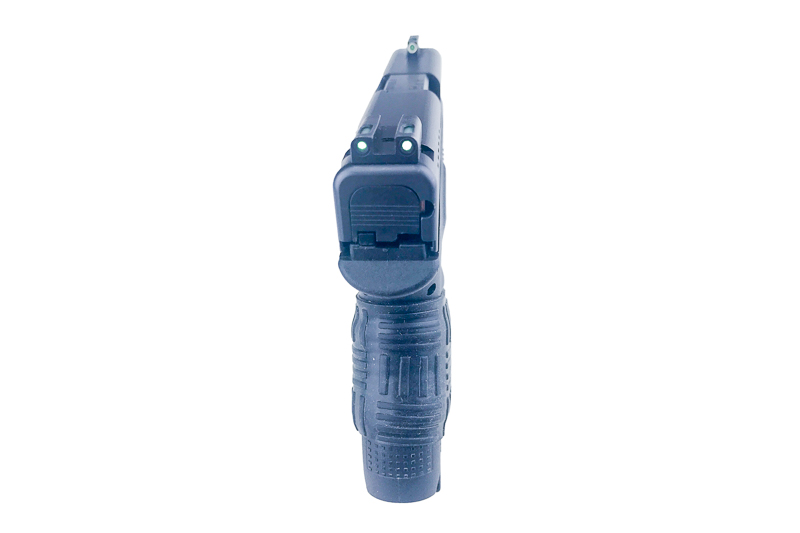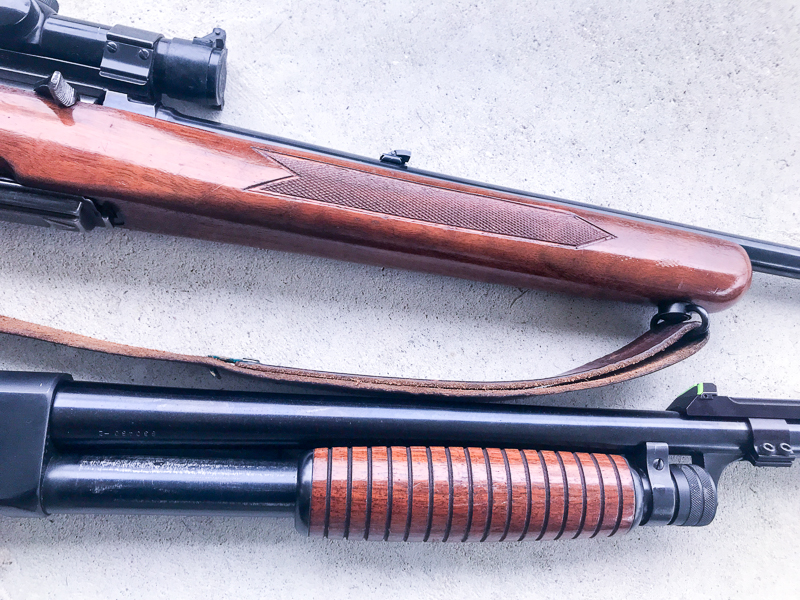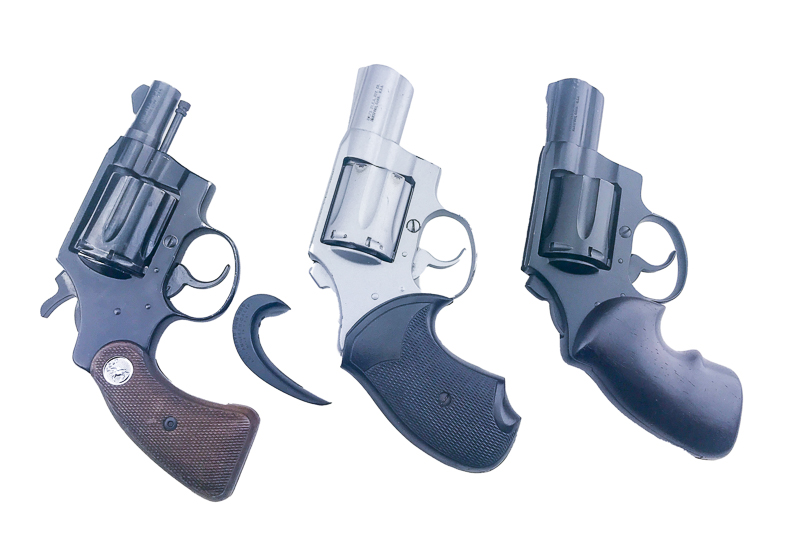In shooting sports, the firearm grip is the interface between the operator and the machine. When you’re using a knife to cut something or a hammer to drive a nail, it’s a bad thing if the device slips in your hand. The same is true with guns. All guns.
You don’t have to spend too much time on YouTube to find videos of a “newbie” shooting a high-powered handgun like a .500 Magnum, and at the shot, the gun spins out of the hand from recoil and whacks the shooter in the head.
Nor do you have to spend much time watching folks on public shooting ranges who have to re-adjust their grip after every shot because the pistol or revolver has moved inside their grasp. Too weak of a grip can even prevent the gun from firing. With a semi-automatic pistol, the dreaded “limp-wrist malfunction” occurs because the gun requires the slide to cycle against the abutment of a rigidly held frame.

Factors of a Loose Grip
If a too-weak grasp allows the frame to recoil back along with the slide, the momentum that should be running the slide dissipates through the hand, failing to return to battery or even a stove-pipe “jam” with the spent casing caught in the ejection port. One help is a neoprene grip sleeve, as seen on G42 .380 in the lead photo above.
With a revolver, particularly the older style service revolvers and snubbies that came with the slim stocks we in the business called “splinter grips,” we would often see the gun roll back in the hand until the hump at the back of the grip frame slipped under the web of the hand. After a few shots, the gun had rolled back enough that the web of the hand blocked the hammer from getting far enough back to fire the next shot, literally “jamming” the gun with the shooter’s hand.
With some of today’s popular slim-frame concealed carry auto pistols, the grips are so slim that the hollow palm has little contact with the sides of the grip, and the gun can actually turn a bit in the hand, altering the trigger finger’s contact with the trigger.
And the grasping issues aren’t limited to handguns.
Long Gun Grip Issues
As an instructor, my shotgun training is limited to defensive usage, meaning every shot fired during the class has powerful buckshot and slug loads. Unfortunately, many students come in having never fired their scattergun with anything but super-light-kicking trap loads, such as the famously soft Winchester AA round. Their time on the clay bird ranges has habituated them to hold the forend lightly, sometimes even with just thumb and forefinger applying pressure to the forend. Even though we warn them about this before the first live round is fired, some revert to the light hold—and we see the front of the gun literally jump out of their forward hand upon recoil.
There are very good reasons why the forends and slide handles of rifles and shotguns are generally checkered or grooved, such as keeping that forward hand in place and preventing slippage.

Think for a minute how easy it is for this to go really, really bad. You have commenced a string of rapid-fire, so, of course, your finger is still on the trigger of your semi-automatic shotgun. Suddenly, the front end jumps out of your hand, and the muzzle begins to drop. Not only will Mother Nature tell you to convulsively tighten your grasp on something you’re dropping, but the weight of the shotgun is suddenly pulling the trigger down against your trigger finger — BOOM!
It would get worse if you had a legally registered SBS (Short Barrel Shotgun) or the style of scattergun popularized by Mossberg’s Shockwave, with a stubby 14” barrel that truncates just ahead of the slide handle. Suppose the grasp has been too light as your hand runs the slide forward, and the hand slips off. In that case, that muzzle will immediately start to drop—with your finger still on the trigger for the anticipated next shot—and the muzzle will be right in line with that over-traveled hand when the unintended discharge of a twelve gauge round occurs.
Let’s look at solutions.
Preventing Slippage
Let’s start with the Shockwaves and legit SBS shotguns we discussed. Several come with a built-in hand sling intended to surround the forward hand and prevent the sort of disaster recently discussed. The NYPD Stakeout Unit had them on the 14” barrel Ithaca Model 37 shotguns they used to good advantage in winning an awesome number of gunfights. Another approach: when I visited the US Secret Service training center in Beltsville, Maryland, their armorer Ray Steele showed me the guard he fitted to the front of the agents’ short-barrel Remington 870 pump guns. They succeeded in serving the same safety purpose.
Revolvers?
With those “splinter-grip” wheel guns of yore or single action revolvers with the Colt-style “plow handle” grip shape, one way to prevent the gun rolling up in your hand so bad it had to be re-gripped was to tuck the pinky finger under the bottom front of the butt.
A more effective answer was found in altering the grip profile. Something as simple as a grip adapter would go far toward solving the problem. So would custom stocks that filled the area master instructor Tom Givens calls “the sinus,” the space between the back of the trigger guard and the front of the grip frame. Going with something like Craig Spegel Boot Grips helped even more and maintained maximum compactness. Pachmayr Compac grips, if you didn’t mind a bit more bulk, put some cushy material between the revolver’s backstrap and the web of the hand, providing another leverage point to prevent roll-up as well as softening felt recoil and giving the pinky finger room to apply some stabilizing leverage.

Ever notice that auto pistols don’t roll up in your grasp because the back of the frame is locked solid against the web of the hand? Dave Lauck’s revolver grips from D&L Sports and Trausch revolver grips are cut to do the same thing.

Semi-Automatic Pistols?
You won’t get roll-up, but you can get a bit of lateral twisting in the hand in rapid fire, particularly with the hotter calibers. Solutions include sharply checkered stocks and checkering or stippling on the front or back of the grip frame. One advantage of today’s dominant polymer-frame pistols is that they lend themselves to customized stippling, checkering, and even re-shaping. Look at the different approaches to these four Glocks:

Slip-on grip sleeves for semi-auto pistols – most often applied to polymer frames – can also have palm swells that fill the hollow of the grasping hand. This gives more machine-to-operator contact and more friction to prevent slippage. With the slip-on models, just be careful that they don’t slide down far enough to block the magazine well. And, please, don’t use them on pistols with grip safeties, which the sleeve can put into the “fire” position. If you’ve been in a self-defense shooting and opposing lawyers are trying to make you look reckless, don’t give them the argument: “The defendant is so careless with firearms that he deactivates the safety devices on deadly weapons!”
Bottom Line
Between trigger pulling and recoil, any firearm can be diverted off target with a slipped grip, and as we’ve seen above, that factor can be culpable in tragic shooting accidents. If you’ve seen the possibility beforehand, you can take steps to keep bad things from happening.


